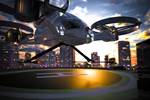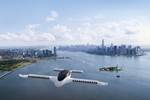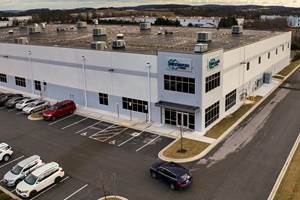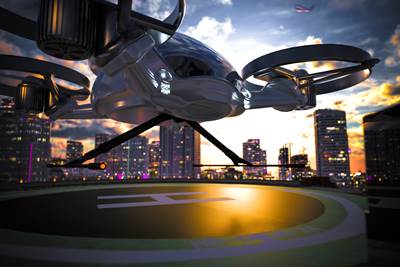Volocopter completes Bruchsal, Germany production site
The company aims to produce 50+ carbon fiber composites-intensive electric air taxis per year, aiming for first commercial services in 2024.
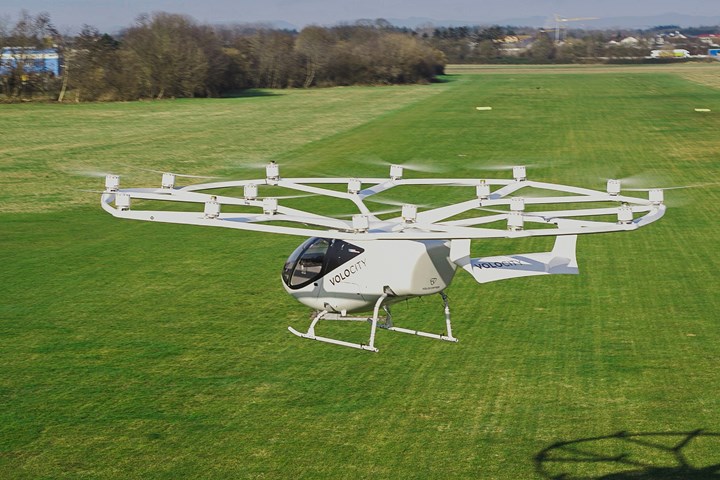
The VoloCity aircraft flying in Bruchsal, Germany. Photo Credit: Volocopter GmbH
Urban air mobility (UAM) company Volocopter GmbH (Bruchsal, Germany) announces the opening of its production facilities in Bruchsal, including a new hangar that will host the company’s final assembly line with an air field to conduct development flight tests and quality checks. This is the final step of the production setup that Volocopter has been expanding in Bruschsal over the past 18 months.
Volocopter develops electrically powered air taxis, with a family of aircraft that includes the VoloCity, VoloRegion and VoloDrone. The company reports that it is the first electric vertical takeoff and landing (eVTOL) company to receive Design Organisation Approval (DOA) from the European Union Aviation Safety Agency (EASA). The German company has committed to launching commercial air taxi services in cities like Singapore, Rome, NEOM, and Paris as early as 2024.
According to the company, Volocopter’s production facilities have the capacity and regulatory approval to assembly 50+ VoloCity aircraft each year. All of its company-owned production facilities will be ramped up to full production in April 2023.
The company’s EASA certification is said to cover the entire VoloCity production process, including manufacture of carbon fiber composite parts, all aspects of the electric propulsion unit, final assembly with decking of the propulsion system and fuselage, and extensive end-of-line flight tests.
The company held a ribbon cutting ceremony at its new hangar in Bruchsal on April 4. The event also featured a crewed flight of the Volocopter 2X. Key guests included Dr. Volker Wissing, Federal Minister of Digital Affairs and Transport; Winfried Kretschmann, Minister of the State of Baden-Württemberg; Dr. Anna Christmann, Federal Government Coordinator for German Aerospace Policy; and upward of 70 business and political representatives.
“Right here is where the aircraft that will change how humanity moves about cities will take off and make its way across the world,” says Dirk Hoke, CEO of Volocopter. “This region is known for transforming mobility — the bicycle, the car and soon Volocopter, too. Electric air taxis and Volocopter in particular is a technology made in Germany that will make the world a more sustainable place.”
“The VoloCity has completed the critical design review — and that’s the aircraft we’re ready to produce, with enough leeway for further learnings derived from flight testing. It’s no easy task to set up a production facility for an entirely new type of aircraft, but my team has done a phenomenal job,” says Andreas Fehring, chief supply chain officer of Volocopter, and program manager of VoloCity.
“Germany is already a world leader in the development of air taxis, thanks in part to Volocopter’s great pioneering spirit. I would like to support and build on this leading role by creating a framework that enables innovation and progress. We are working with key industry players on a strategy for air taxi operations here in Germany, in which all technical and legal issues are addressed without delay. We are doing this so that the first drones carrying people and goods can take off very soon,” says Dr. Volker Wissing, federal minister of Digital and Transport.
Related Content
Plant tour: Joby Aviation, Marina, Calif., U.S.
As the advanced air mobility market begins to take shape, market leader Joby Aviation works to industrialize composites manufacturing for its first-generation, composites-intensive, all-electric air taxi.
Read MoreMidnight production aircraft completes full transition flight
This is Archer’s second full-scale eVTOL aircraft to achieve this milestone, critical to being able to carry commercially viable passenger payloads.
Read MoreComposite sidewall cover expands options for fire-safe rail components
R&D project by CG Rail explores use of carbon fiber-reinforced thermoplastics and recycled manufacturing scrap to meet fire safety, weight and volume targets.
Read MoreHexagon Purus opens new U.S. facility to manufacture composite hydrogen tanks
CW attends the opening of Westminster, Maryland, site and shares the company’s history, vision and leading role in H2 storage systems.
Read MoreRead Next
Composites opportunities in eVTOLs
As eVTOL OEMs seek to advance program certification, production scale-up and lightweighting, AAM’s penetration into the composites market is moving on an upward trajectory.
Read MoreComposite aerostructures in the emerging urban air mobility market
In the not too distant future, point-to-point, limited-distance, piloted and autonomous air travel for people and cargo will be the norm. Composites will make it possible.
Read MoreVIDEO: High-volume processing for fiberglass components
Cannon Ergos, a company specializing in high-ton presses and equipment for composites fabrication and plastics processing, displayed automotive and industrial components at CAMX 2024.
Read More
.jpg;width=70;height=70;mode=crop)
